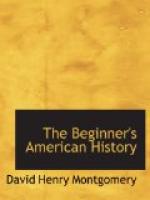The emigrants named their settlement St. Mary’s, because they had landed on a day kept sacred to the Virgin Mary.[3] The Indians gave up one of their largest wigwams to Father White, one of the priests who had come over, and he made a church of it. It was the first English Catholic Church which was opened in America.
[Illustration: Map of Maryland and Virginia.]
The Indians and the settlers lived and worked together side by side. The red men showed the emigrants how to hunt in the forest, and the Indian women taught the white women how to make hominy, and to bake johnny-cake before the open fire.
[Footnote 3: March 25th: Annunciation or Lady Day.]
79. Maryland the home of religious liberty.—Maryland was different from the other English colonies in America, because there, and there only, every Christian, whether Catholic or Protestant, had the right to worship God in his own way. In that humble little village of St. Mary’s, made up of thirty or forty log huts and wigwams in the woods, “religious liberty had its only home in the wide world.”
But more than this, Lord Baltimore generously invited people who had been driven out of the other settlements on account of their religion to come and live in Maryland. He gave a hearty welcome to all, whether they thought as he did or not. Thus he showed that he was a noble man by nature as well as a nobleman by name.
80. Maryland falls into trouble; the city of Baltimore built.—But this happy state of things did not last long. Some of the people of Virginia were very angry because the king had given Lord Baltimore part of what they thought was their land. They quarrelled with the new settlers and made them a great deal of trouble.
Then worse things happened. Men went to Maryland and undertook to drive out the Catholics. In some cases they acted in a very shameful manner toward Lord Baltimore and his friends; among other things, they put Father White in irons and sent him back to England as a prisoner. Lord Baltimore had spent a great deal of money in building up the settlement, but his right to the land was taken away from him for a time, and all who dared to defend him were badly treated.
St. Mary’s never grew to be much of a place, but not quite a hundred years after the English landed there a new and beautiful city was begun (1729) in Maryland. It was named Baltimore, in honor of that Lord Baltimore who sent out the first emigrants. When the Revolutionary War broke out, the citizens of Baltimore showed that they were not a bit behind the other colonies of America in their spirit of independence.
81. Summary.—King Charles the First of England gave Lord Baltimore, an English Catholic, a part of Virginia and named it Maryland, in honor of his wife, Queen Mary. A company of emigrants came out to Maryland in 1634. It was the first settlement in America in which all Christian people had entire liberty to worship God in whatever way they thought right. That liberty they owed to Lord Baltimore.




